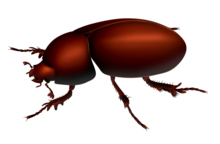Tyrannasorus rex
| Tyrannasorus rex Temporal range: Miocene
| |
|---|---|

| |
| Life restoration | |
| Scientific classification | |
| Domain: | Eukaryota |
| Kingdom: | Animalia |
| Phylum: | Arthropoda |
| Class: | Insecta |
| Order: | Coleoptera |
| Suborder: | Polyphaga |
| Infraorder: | Scarabaeiformia |
| Family: | Hybosoridae |
| Genus: | †Tyrannasorus Ratcliffe & Ocampo, 2001 |
| Species: | †T. rex
|
| Binomial name | |
| †Tyrannasorus rex | |
Tyrannasorus rex is an extinct species of hybosorid beetle and the sole member of the genus Tyrannasorus. The species is known from a single, presumably female fossil specimen found trapped in amber in the Dominican Republic. Dominican amber is today dated to the Miocene epoch (15 to 20 million years ago). The species was broadly similar to modern-day hybosorids of genera Apalonychus and Coilodes. The name of the species is a word play on another, much larger extinct species.
Taxonomy
[edit]Tyrannasorus rex is a species of hybosorid beetle. It is the sole species of the genus Tyrannasorus.[1] The species and the genus were described in 2001 by the entomologists Brett C. Ratcliffe and Federico Carlos Ocampo.[2]
The etymologies of the scientific names of the genus and the species are given by Ratcliffe and Ocampo. Tyranna, which they describe as "the loosely formed stem" of the genus name, comes from the Latin tyrannus, meaning "master" or "tyrannical". The second part of the genus name comes from the Latin sorus, which means "hump" or "pile"; the same suffix is used for the name of the family Hybosoridae and its type genus, Hybosorus. The resulting name, "tyrannical hump", refers to the "possible state of 'mind'" of the holotype specimen when she became fatally trapped in sticky tree sap.[3]
The specific epithet rex means "king" in Latin. The authors state that the generic name is similar and the specific epithet identical to those of "another famous, and much larger, species of extinct animal".[3] Naturalist John Acorn explains that both Tyrannasorus rex, the beetle, and Tyrannosaurus rex, the dinosaur, can both correctly be called T. rex, citing this as an example of confusion that may arise from abbreviating generic names.[3]
Holotype
[edit]The holotype specimen was found enclosed in amber in the Dominican Republic in the region of West Indies.[3] Ratcliffe and Ocampo surmise that the specimen is female based on similarities to the female specimens of Apalonychus, an extant hybosorid genus from the West Indies. Some parts of her body, especially the abdomen, are obscured by the dark pigmentation of the amber. A pair of prolegs, a pair of middle legs, and a pair of posterior legs are all clearly visible. The specimen is now deposited in the American Museum of Natural History, New York.[3]
The specimen was trapped in the resin produced by Hymenaea protera, a leguminous tree which is now also extinct.[3] Joseph B. Lambert, James S. Frye, and George Poinar, Jr. dated the Dominican amber to Oligocene or Eocene,[4] but later research by Manuel Iturralde-Vinent and Ross MacPhee found this to be erroneous and dated all Dominican amber to 15 to 20 million years ago, which corresponds to Miocene. [5] The exact provenance of the amber cannot be determined because researchers buy it from dealers. Ratcliffe and Ocampo presume that it came from the mountain range north of Santiago de los Caballeros.[3]
Description
[edit]Unlike other hybosorids from the West Indies, whose antennae are 10-segmented, Tyrannasorus rex had nine-segmented antennae. The species is most similar to the genera Coilodes and Apalonychus; their shared characteristics include convex and not quite spherical body and reddish-brown colour. The most prominent difference between Coilodes and Tyrannasorus is in the shape of the antennal club, which is slightly concave in Tyrannasorus but cup-shaped in Coilodes. Furthermore, the former's labrum is wider than the latter's and, unlike the former's, the anterior margin of the latter's pronotum is curvy.[3]
Species of the genus Apalonychus have a much more elongated club of the antenna compared to Tyrannasorus and, unlike Tyrannasorus, eyes of the specimen are subglose and easily visible in dorsal view. Their labrum is also wider than that of Tyrannasorus and the anterior margin of their pronotum is not curvy. The insect's elytra have a smooth surface.[3]
References
[edit]- ^ Jameson, Mary Liz; Ratcliffe, Brett C. (2006). Scarabaeoidea in the 21st Century: A Festschrift Honoring Henry F. Howden. Coleopterists Society monographs Patricia Vaurie series. Coleopterists Society. p. 142. ISBN 978-0-9726087-6-3. Retrieved 16 January 2025.
- ^ Ratcliffe, Brett C.; Ocampo, Federico Carlos (2001). "Tyrannasorus rex Ratcliffe and Ocampo, a New Genus and Species of Miocene Hybosorid in Amber from the Dominican Republic (Coleoptera: Scarabaeoidea: Hybosoridae)". The Coleopterists Bulletin. 55 (3): 351–355. doi:10.1649/0010-065X(2001)055[0351:TRRAOA]2.0.CO;2. JSTOR 4009640. S2CID 10948175.
- ^ a b c d e f g h i Acorn, John (2007). Deep Alberta: Fossil Facts and Dinosaur Digs. University of Alberta. pp. [, page needed], . ISBN 978-0-88864-481-7.
- ^ Lambert, Joseph B.; Frye, James S.; Poinar, George O., Jr. (1985). "Amber from the Dominican Republic: analysis of nuclear magnetic resonance spectroscopy". Archaeometry. 27: 43–51. doi:10.1111/j.1475-4754.1985.tb00345.x.
{{cite journal}}: CS1 maint: multiple names: authors list (link) - ^ Iturralde-Vinent, Manuel A.; MacPhee, R. D. E. (27 September 1996). "Age and Paleogeographical Origin of Dominican Amber". Science. 273 (5283). American Association for the Advancement of Science (AAAS): 1850–1852. Bibcode:1996Sci...273.1850I. doi:10.1126/science.273.5283.1850. ISSN 0036-8075.
